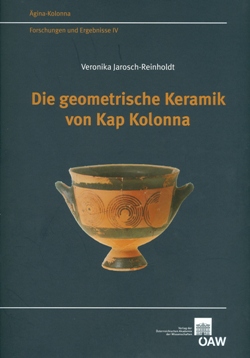

Die vorgelegte protogeometrische und geometrische Keramik stammt zum überwiegenden Teil von Ägina-Kolonna, einem im Nordwesten der Insel ins Meer hinausragenden Felskap, wo bereits vom Neolithikum an eine Siedlung bestanden hatte. Die sehr große Menge an protogeometrischer Keramik macht deutlich, dass die in spätmykenischer Zeit verlassene Akropolis auf Kap Kolonna im 10. Jh. v. Chr. wiederbesiedelt wurde. Von Anfang an bestanden engste Beziehungen der Bewohner Äginas zu Athen, unabhängig von ihrer überlieferten dorischen Abstammung, wurde doch feines, bemaltes Tongeschirr fast ausschließlich von dort importiert. Dabei handelt es sich vor allem um Formen, die beim Gastmahl und Trinkgelage verwendet wurden, wie Trink-, Mischgefäße und Kannen sowie Amphoren zur Anlieferung und Lagerung des Weins. Über zwei Jahrhunderte hat man bei solchen gemeinschaftlichen Trinkritualen, die unter der Patronanz lokaler basileis bzw. einer Phratrie stattfanden und die als Frühform des Apollon-Kultes an dieser Stelle zu deuten sind, attische Gefäße benützt. Erst um die Mitte des 8. Jhts. v. Chr. wurde dieses Monopol Athens vor allem durch Produkte der zunehmend an Bedeutung gewinnenden korinthischen Keramikindustrie, danach auch durch argivische und kykladische Tonwaren gebrochen, sodass bereits für das spätere 8. Jh. v. Chr. ein erweitertes Netz an Handelsbeziehungen und sozialen Kontakten der Ägineten zum ägäischen Raum vorauszusetzen ist. Darüber hinaus lässt sich an der Keramik dieses Zeitraumes eine vorher nicht dagewesene Differenzierung der Gesellschaft erkennen, die Teilnahme unterschiedlicher sozialer Gruppen am Kult, zu denen weniger privilegierte Personen sowie eine durch verfeinerte Tischsitten erstmals fassbare Adelsschicht zählen.
Gedruckt mit Unterstützung des Fonds zur Förderung der wissenschaftlichen Forschung.
…
The Protogeometric and Geometric pottery presented in this volume was mainly found on the Colonna Hill, a cape protruding into the sea in front of the island of Aegina, bearing a settlement from Neolithic times onwards. The high quantities of Protogeometric pottery indicate that the acropolis of Cape Colonna, which was abandoned during the Late Mycaenean times, was resettled in the 10th century B.C. It is apparent that the inhabitants of Aegina had close relations with Athens from the beginning, independent of their transmitted Doric descent, as the decorated ceramic fine wares have been almost exclusively imported from there. The shapes are typical of drinking and dining equipment, such as cups, drinking and mixing vessels, oinochoai and amphorae for the delivery and storage of wine. For more than two hundred years the people of Aegina had been using Attic vessels when celebrating their common drinking rituals, taking place under the patronage of local rulers and-or a phratry, which are very likely to be an early form of the cult of Apollon. From the middle of the 8th century B.C. onwards the Athenian monopoly was broken first of all by the increasing importance of the Corinthian ceramic products and later by Argive and Cycladic pottery. Additionally in the pottery of this time we can see a differentiation in society which did not exist before. Different social groups participated in the rituals, some less privileged but also a new aristocratic class which is evidenced by the refinement of dining customs.
Printed with the support of the Fund for the Promotion of Academic Research.
2009,
978-3-7001-6548-4
978-3-7001-6930-7
319 Seiten, mit Index,
30x23cm, broschiert